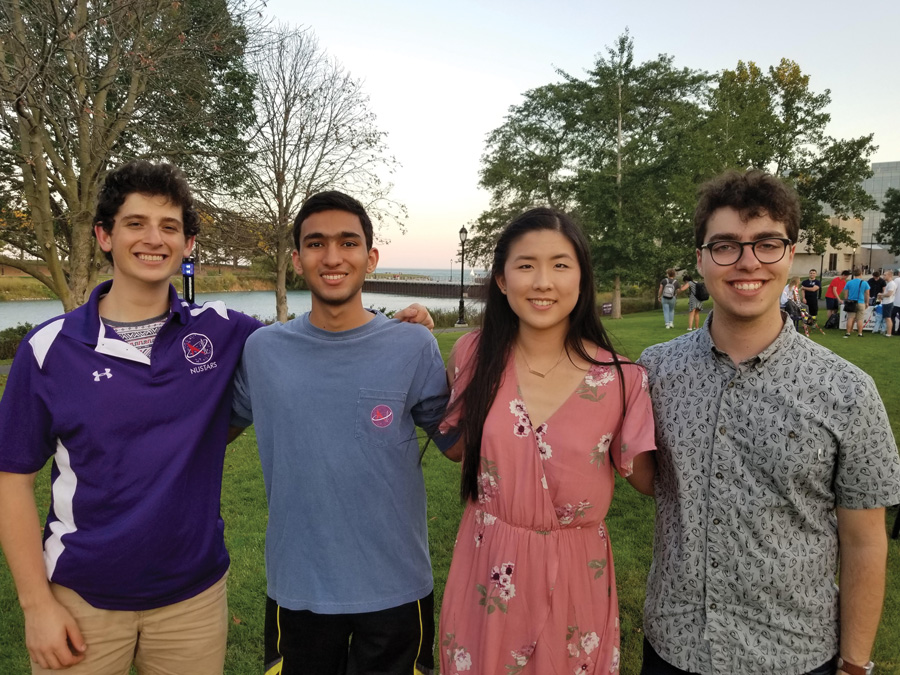Northwestern rocket team to compete for chance to set Guinness World Record
Josh Werblin, Manan Shah, Cindy Chen and Noah Sims are part of a new NUSTARS team that will compete for a chance to set a world record. The team had to design a new type of rocket that will use only Alka-Seltzer and water as fuel.
September 21, 2017
Though the deadline for a chance to set a Guinness World Record is fast approaching, the Northwestern University Space Technology and Rocketry Society is still putting final touches on its rocket. Nevertheless, NUSTARS president Monica Berg is optimistic.
“If there’s one thing NUSTARS is good at, it’s pulling off miracles,” the McCormick senior said.
NUSTARS is an organization that focuses on promoting aerospace, exploration and space technology, as well as competing in various university-level NASA competitions. One of the group’s teams is set to compete in the late-September Bayer-Big Ten Alka-Rocket Challenge, a competition to reach the highest altitude using only Alka-Seltzer tablets and water as fuel.
To begin the challenge, the organization will submit a video of its rocket, which will be judged according to design, execution and creativity. Four finalists from the Big Ten will then travel to the NASA Houston Space Center in November, where they will launch their rockets for a chance to win $25,000 and set the Guinness World Record for highest launch of an effervescent tablet.
Ray Kerins, Bayer’s head of communications, said the company created the competition as part of its Making Science Make Sense initiative. The program aims to inspire students to study science, technology, engineering and mathematics by visiting classrooms and doing science experiments.
Kerins said a lack of STEM graduates has left many science-related jobs vacant in the United States. He said Bayer partnered with the Big Ten because it has a high concentration of doctoral students who graduate from STEM programs.
“What better partner? A partner is someone who believes in the mission that you believe,” Kerins said. “We need more people focused on technology, more mathematicians. Who (is) going to solve the next challenges that society has?”
For NUSTARS, the challenge was moving away from the team’s familiarity with mechanics and aerodynamics to gain a deeper understanding of chemical engineering, Berg said.
McCormick junior Josh Werblin, a member of the four-person team, visited NU’s general chemistry lab this summer to seek help from several postdoctoral fellows. Werblin ran experiments to test the pressure generated from the reaction of Alka-Seltzer and water in an effort to maximize the rocket’s altitude.
Though the rocket is different from the society’s previous designs, Werblin said he expects the creativity to get them through to the final launch in Houston.
“We hope that because it will be lightweight enough it’ll be able to get really high,” he said. “I think we’ll do pretty well.”
The team plans to use the maximum allowed 100 Alka-Seltzer tablets, said lead structural designer Cindy Chen.
The McCormick junior said the rocket uses a unique propulsion system that sits on the outside of the rocket and will detach during takeoff. This system is different from other designs, she said, because not everything is contained in the rocket’s main body.
The team will construct its rocket with a 3-D printer, and preliminary calculations show it could reach an altitude of about 600 to 700 meters, though Chen said that is a “vague, educated guess.”
“I can’t expect (the rocket) to go any altitude because I’ve never done this before,” she said. “The danger in rocketry is that things never go as you expect them to.”
Email: [email protected]
Twitter: @_perezalan_


